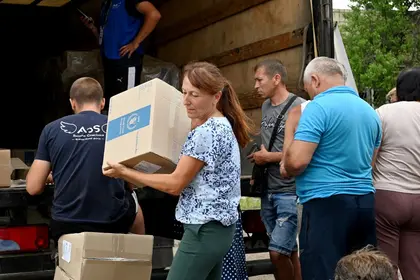A couple of days ago, I was working in the Khlibna café near Lviv Square in Kyiv’s city center. Besides me, there were three other people in the café. We were all bent over laptops. An air raid warning would force the café to close and we would be turned out onto the street. With the spring sun shining through the window, you could almost imagine that all was well with the world.
I was just thinking how quiet Kyiv had been recently when the door of the cafe suddenly opened and a man of about 40, dressed in the garb of a priest, walked in. He entered somewhat theatrically, stopping and looking around, attracting attention. Everyone stared at him. Then he declared, “I have come to pray for peace!”
JOIN US ON TELEGRAM
Follow our coverage of the war on the @Kyivpost_official.
For some three minutes, he uttered words of supplication and then, having fallen silent, he stared at us expectantly, apparently hoping to be compensated for his efforts. The first to give in was a man of about 30, sitting by the window. He surrendered 20 hryvnia (equivalent to about 50 cents). The priest rejoiced then, approaching the donor, placed a hand on his head and intoned another prayer in a half-whisper.
Then he directed his gaze at me. I took out 10 hryvnia, but when the man approached, I asked him what church he was from. He seemed embarrassed. You could see him thinking feverishly. In the end, he said: “From the Volodymyrsky Cathedral.”
“What’s your name?” I asked.
"Father Volodymr!" he answered a little more confidently, pulling the ten hryvnia from my fingers and exiting the café almost at a run.
Once he had gone, I suddenly realized that he had offered to pray for peace and not for victory. Perhaps he was not from Volodymyrsky Cathedral – which belongs to the Kyiv Patriarchate – but from some church of the Moscow Patriarchate. But then, thinking about his clothes and his manner, I concluded that this man was just a poor actor, playing the role of a priest.
His performance made me think of the many professional beggars who before the war often appeared on our streets, on the subway, and local trains, always repeating the same text: “We are not locals. We lost our house and all our documents in a fire. Now we have nowhere to live. Please, help in any way you can!”. I don’t think I have heard those words at all since this war started.
As European countries reduce financial assistance to Ukrainian refugees, one can see more Ukrainians begging on the streets of Europe. While many refugees have found jobs and started paying their way, for some it is difficult to become financially independent in a foreign country. For them, is it hard to imagine surviving without social assistance.
In Ukraine itself, the state is also reducing its program of assistance for internally displaced persons (IDPs). Fortunately, there are already well-organized IDP self-help groups and NGOs that support them.
Indeed, in response to the war, society has mobilized itself to help those in need and especially to support the armed forces. Ukrainians from all backgrounds continue to donate to the Armed Forces of Ukraine out of their own pockets and spend their time and other resources helping the war effort.
Vehicles for military units at or near the front line have long been a focus of fundraising efforts. Now, a team of friends in the town of Lysyanka, Cherkasy region, has created a workshop for repairing old motorcycles – a favorite mode of transport in Ukrainian villages, where almost every household has an old motorbike at the back of the garage.
Calling themselves “The Repair Battalion”, the team got started on five bikes brought to them from neighboring villages. Since then, work has not stopped. Those motorcycles that cannot be repaired are used for spare parts for other bikes.
“A motorcycle can survive at the front for more than two months while the lifespan of a car is between 20 minutes and two weeks!” explains the head of the “The Repair Battalion” Oleksandr Korolenko. “Cars are shot at and destroyed by shells. You can't drive a car through the forest. You can get stuck in a muddy field. Even some Jeeps can’t manage those roads, but a motorcycle can go everywhere.”
Until a year ago, in Kherson region, the Russians were even using horses stolen from local farms to deliver ammunition and soldiers. But, in the end, this turned out to be impractical, because horses need to be looked after, the stables must be maintained, and the animals have to be fed.
We do not know Ukraine’s transport losses in this war, but according to reports from the Ukrainian General Staff, Russia has lost more than 15,000 units of non-military equipment – trucks, fuel tankers, and other vehicles in the occupied territories of Ukraine.
Ukrainians bought tens of thousands of old jeeps and pickups from Europe for their army. If the volunteers from Lysyanka are correct and most of those cars survive for less than two weeks, then it is easy to imagine the volume of destroyed automobile equipment, which could end up being melted down by the largest buyer of scrap metal in the world – China.
You can also highlight the text and press Ctrl + Enter



